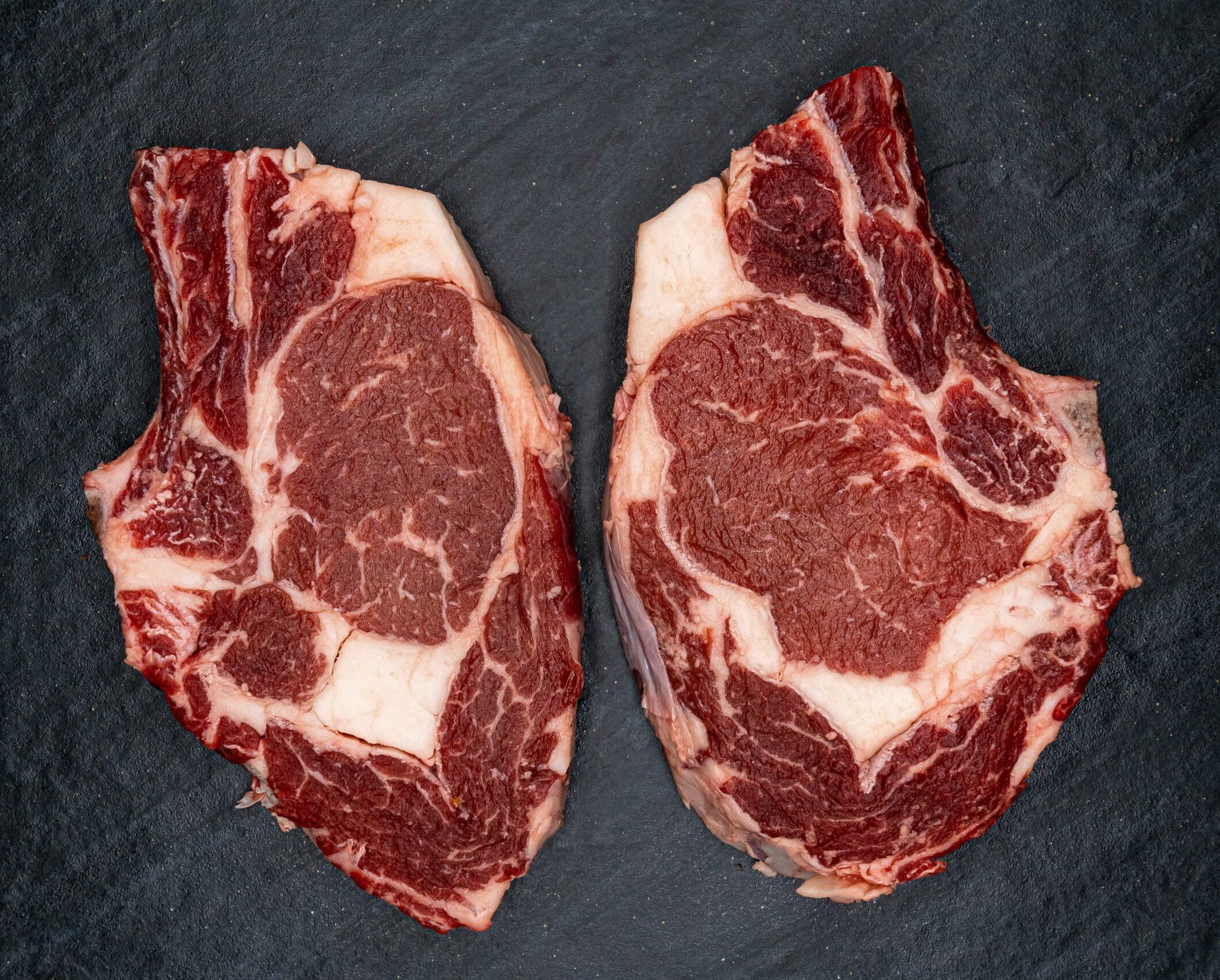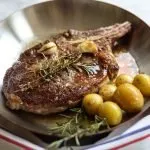Cooking a juicy, flavorful bone-in ribeye steak at home can seem daunting. However, with the right techniques, ingredients, and a little patience, you can achieve restaurant-quality results in your own kitchen. This tender cut of beef deserves care and attention to truly shine.
In this detailed guide, I’ll walk you through my foolproof process for cooking bone-in ribeyes, from start to finish. Whether grilling, broiling, or pan-searing, these tips will help you nail the preparation and cook your steaks to perfection every time. Let’s get cooking!
Why Go Bone-In?
Ribeye steaks are flavorful, marbled cuts taken from the rib section, one of the eight primal cuts of beef. The bone-in ribeye consists of a rib bone with the signature “eye” of meat attached. This extra bone lends even more richness and depth to an already delicious steak.
Compared to boneless ribeye, the bone-in cut contains more internal fat marbling due to its location closer to the bone The bone itself imparts extra flavor as the meat cooks Because it retains more natural juices, the bone-in ribeye generally cooks up more tender and moist than its boneless counterpart.
For serious steak-lovers, the intense, concentrated beefiness of a bone-in ribeye is tough to beat. When prepared properly, every bite bursts with buttery, beefy flavor.
Picking the Perfect Cut
When selecting your ribeyes, choose steaks that are 1-1 1⁄2 inches thick, with ample marbling and a nicely distributed fat cap. Thinner cuts run the risk of overcooking, while thicker cuts may require more time on the grill or in the pan.
I recommend purchasing your steaks from a trusted butcher or meat market. Ask them for expert advice on picking the highest quality cuts for the best potential results. Prime grade steaks, marked with the most marbling, tend to deliver superior tenderness and taste over lower grades.
Plan on around 1 pound of boneless ribeye per person. Two massive, bone-in ribeyes can easily feed four people when sliced properly. Just adjust for larger or smaller appetites as needed.
Proper Seasoning
The rich flavor of ribeye really sings with just a simple coating of salt and pepper. For top results, I like to use coarse sea salt or kosher salt to generously season the steaks at least 40 minutes prior to cooking. This gives the salt time to penetrate deep into the meat.
Right before hitting the heat, I’ll add a final sprinkling of fresh cracked black pepper. Resist over-seasoning, and let the natural flavors shine through. A simple herb butter melted on top while cooking can also impart lovely complementary flavors.
Achieving the Ideal Doneness
Ribeyes shine when cooked medium-rare, yielding a reddish-pink center full of juicy flavor. For food safety, the USDA recommends an internal temperature of at least 145°F. However, many steakhouses aim for about 135°F for a perfectly pink finish.
Regardless of your target temperature, always allow your ribeyes to rest after cooking for 5-10 minutes before cutting into them. This resting period enables them to reabsorb their natural juices for increased tenderness and moisture.
Taking the internal temperature with a reliable meat thermometer is the safest way to gauge doneness. For medium-rare, remove the steaks between 135-140°F and allow carryover cooking to finish the job during resting.
Sear then Finish Low and Slow
My favorite cooking method for bone-in ribeye involves an initial hot sear followed by slower cooking at a more moderate temperature.
First, heat up your grill, grill pan, broiler, or cast iron skillet over high heat. Add just a bit of oil or butter to the hot cooking surface before laying the steaks down. Sear the steaks for 2-3 minutes per side to caramelize the outside and form a flavorful crust.
Next, transfer the steaks to a 250-275°F oven, or lower your grill/stovetop heat, to gently finish cooking to your desired doneness. This slower cooking step limits further charring while perfectly roasting the inside.
Monitor the temperature, and remove the steaks once they reach your target. Whether grilling, broiling, roasting or pan-searing, this sear-then-slow technique works wonders!
Step-By-Step Instructions
Follow these simple steps for flawlessly cooked bone-in ribeyes every time:
1. Pat steaks dry: Blot steaks with paper towels to remove excess surface moisture for better browning.
2. Generously season with salt: Coat steaks all over with coarse salt about 40 minutes prior to cooking.
3. Add fresh cracked pepper: Right before cooking, sprinkle freshly cracked pepper to finish the seasoning.
4. Preheat cooking surface: Heat grill, grill pan, broiler or cast iron skillet over high heat until smoking hot.
5. Add small amount of oil: Use just enough oil or butter to lightly coat the cooking surface before adding steaks.
6. Sear steaks 2-3 minutes per side: Lay steaks down and allow to sear undisturbed to form a nice crust.
7. Finish cooking in 250°F oven: Transfer steaks to oven or lower heat on stovetop/grill to gently finish cooking.
8. Check temperature: Monitor temperature and remove steaks from oven at 135°F for medium-rare.
9. Allow steaks to rest: Let steaks rest 5-10 minutes before slicing to allow juices to reabsorb.
10. Serve and enjoy! Slice against the grain and savor the tender, juicy flavor.
Cooking on a Grill
Outdoor grilling adds wonderful smoky undertones to beef. Get your charcoal or gas grill as hot as possible, brush the grates with oil, and throw on your ribeyes. After searing a few minutes per side over direct high heat, move the steaks to indirect heat to finish roasting until your desired doneness.
Hardwood charcoal or wood chips (mesquite, hickory) impart the most flavor. Let the steaks rest before digging in to be sure they retain all their juices.
Pan Searing on the Stove
For an easy stovetop method, use a blazing hot cast iron or stainless steel skillet. Melt a bit of butter or oil, then lay in the steaks. Allow them to sizzle undisturbed so the exteriors caramelize. Flip after a couple minutes once nice crusting appears, then pop the whole pan into a hot oven to finish cooking gently.
Use metal tongs for flipping steaks—piercing them with a fork allows flavorful juices to escape. Remember to rest the steaks once cooked before slicing and serving.
Broiling for Quick and Easy
Set your oven broiler to high and position an oven rack about 6 inches from the heating element. Place a wire rack inside a broiler pan, then arrange the steaks on top and slide under the broiler. The intense overhead heat will deeply caramelize the meat.
Flip the steaks over halfway through cooking time. Keep a close eye to avoid charring. For flavor, try topping with garlic herb butter a minute or two before removing from the oven. Don’t forget to rest before cutting for maximum juiciness.
Common Mistakes to Avoid
Steaks and high heat can spell disaster for amateur cooks. Sidestep these common pitfalls for the best shot at ribeye success:
-
Skipping the resting period – Always let steaks rest after cooking!
-
Cutting into steak right after cooking – Let juices redistribute for tenderness.
-
Moving steaks too much – Leave undisturbed while searing for proper browning.
-
Cooking over very high heat the entire time – Finish gently after an initial sear.
-
Poking steak repeatedly to check doneness – Use a meat thermometer instead.
-
Adding steak straight from fridge to hot pan – Allow meat to come to room temp first.
-
Overcooking and drying out the meat – Cook quickly and use a thermometer.
Serving Suggestions
A properly cooked bone-in ribeye really doesn’t need much in the way of heavy sauces or complicated sides. I prefer to highlight the incredible meat with simple accompaniments:
- Roasted asparagus or green beans
- Mashed or baked potatoes
- Sautéed mushrooms
- Crisp leafy salad
- Crusty artisanal bread
A nice red wine, like Cabernet Sauvignon or Malbec, pairs beautifully with steak. For an elegant presentation, serve sliced pieces of steak fanned out next to each other on the plate. Spoon any cooking juices over the top just before serving.
Storing and Reheating Leftovers
Properly stored, leftover ribeye steaks will keep in the refrigerator for 3-4 days. Place unsliced steaks in a container between layers of plastic wrap or foil. Reheat gently in a low oven or skillet just until warm; microwaving can ruin the tender texture.
For the best flavor and texture, try to avoid freezing ribeyes. However, they can be frozen for up to 4 months if well-wrapped. Thaw in the refrigerator before reheating.
Make This Meaty Classic at Home
A good bone-in ribeye steak is hard to beat for indulgence and big, beefy flavor. While considered a restaurant-quality cut, ribeyes can absolutely be prepared to perfection at home with the right techniques. Keep these tips in mind for your next special occasion steak dinner.

ABOUT LE CHEF’S WIFE

Bonjour! I am Anina Belle. I translate the fancy cooking of my Michelin-star trained French Chef Husband, Le Chef, into easy to make dishes that busy people with no culinary training (like me!) can make at home. We have two young kids (5 and 2) and I have a full time job in hospitality in addition to this blog. I strongly believe that even busy people deserve to eat well at home.
I share our home cooking on Instagram, pinterest and tiktok. Sign up for my newsletter to be the first to receive my new recipes and have advance access to cooking classes. I look forward to cooking with you!

How to reheat a steak?
Never, ever reheat a steak in the microwave. It literally steams the steak and you end up with boiled meat. Not good. I like to thinly slice the leftover steak and quickly reheat it in a hot pan with some olive oil. The steak slices can be eaten as is or turned into a seared steak salad or even steak tacos!
Ribeye Steak Recipe: Cast Iron Bone-In Ribeye Steak (Cowboy Steak)
FAQ
How do you cook a bone-in rib steak?
For the perfect medium-rare Bone-In Ribeye steak, sear in a skillet for 13–15 minutes for a 1-inch steak, and 15–17 minutes for a 1½ inch steak, turning about 1 minute before the halfway point. A meat thermometer should read 130°F. Rest your steaks for 5 minutes before serving, covering lightly with foil.
How to cook a rib of beef bone-in?
Roast for 20 minutes at 220C/fan 200C/gas 7, then turn the oven down to 160C/fan 140C/gas 3. Cook for 20 minutes per 450g for medium/15 minutes per 450g for rare. Rest the meat for 15-30 minutes in a warm place. Slice the meat neatly away from the bone.
Is bone-in rib steak good?
When choosing between a rib steak and a ribeye, it comes down to whether you want a bone-in cut or a boneless cut. The bone-in rib steak is more of a traditional ranch steak that is Fred’s favorite. When grilling, the bone imparts additional flavor into the meat, but it also acts as an insulator.
What is the best method to use when cooking a rib steak?
Grilled Ribeye steak is full of flavor and is the best way to prepare this cut. But there are many other methods that are also delicious, such as pan-seared Ribeye steak, broiled Ribeye steak, and even air fryer Ribeye steak.
